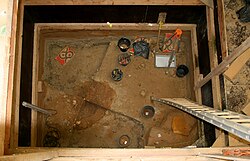Neolithic flint mines of Spiennes
| Criteria | Cultural: (i), (iii), (iv) |
|---|---|
| Reference | 1006 |
| Inscription | 2000 (24th Session) |
| Area | 172 ha (430 acres) |
| Website | www |
| Coordinates | 50°25′11″N 3°58′55″E / 50.41983°N 3.98183°E |
The Neolithic flint mines of Spiennes are among the largest and earliest
Description
Discovered in 1843, the first excavations were undertaken by the mining engineer Alphonse Briart and two others during railway construction in 1867,[3] with results presented to the International Prehistoric Congress held in Brussels in 1872.[4] Intermittent excavations have been carried out up to the present day.[5]
The Mines of Spiennes cover some 100 ha (250 acres) of downland four miles south-east of the city of Mons. The site is dotted with millions of scraps of worked flint and numerous mining pits, that Neolithic settlers have gradually turned into vertical mine shafts to depths of over 10 m (33 ft). Underneath is an elaborate man-made network of caverns accessible via the many shafts.[2][6]
A seminal stage of human inventiveness, technological and cultural application and progress, the transition between
The rough-outs were exchanged over a wide area, about 150 km (93 mi), and were often polished at their destination. Polishing strengthens the final product, making the axe- or adze-head last longer. The smooth surface also aids the cutting action by lowering friction with the wood. The axes were used initially for forest clearance during the Neolithic period, and for shaping wood for structural applications, such as timber for huts and canoes.
-
flint mines of Champ à Cailloux
-
mines of Champ à Cailloux
-
Excavations in Champ à Cailloux
Conservation and access
An interpretative centre called SILEX'S opened in spring 2015. There is a museum on the surface and it is normally possible to descend into a mine.[7][8]
Similar sites
The site has been compared with
-
Deer antler pick (Grimes Graves)
-
Late Stone Age flint axe, about 31 cm long
References
- ^ "Neolithic Flint Mines of Petit-Spiennes: Official website". Archived from the original on 31 December 2007. Retrieved 16 December 2007.
- ^ a b "Neolithic Flint Mines at Spiennes (Mons) - UNESCO World Heritage Centre". Whc.unesco.org. Retrieved 24 January 2017.
- ^ Alphonse Briart et al., Rapport sur les découvertes géologiques & archéologiques faites à Spiennes en 1867 (Mons, 1872), on Google Books.
- ^ Thomas Wilson, Arrowpoints, Spearheads, and Knives of Prehistoric Times (Washington DC, 2007), ch. 4.
- ^ "A visit to Spiennes Flint Mines, Belgium". Journal.lithics.org. Retrieved 24 January 2017.
- ^ "Neolithic flintstones mines in Spiennes". Minesdespiennes.org. Archived from the original on 31 December 2007. Retrieved 24 January 2017.
- ^ "Silexs Mons Neolithic flint mines of Spiennes". En.silexs.mons.be. Retrieved 24 January 2017.
- ^ "Neolithic flint mines in Spiennes - SILEX'S Mons". Opt.be. Retrieved 24 January 2017.
- Bibliography
- C. Guillaume, Ph. Lipinski & A. Masson: Les mines de silex néolithiques de la Meuse dans le contexte européen. Musées de la Meuse, Sampigny 1987. (in French)
- F. Gosselin: Un site d'exploitation du silex à Spiennes (Hainaut), au lieu-dit "Petit-Spiennes". Vie archéologique 22, 1986, 33-160. (in French)
- F. Hubert: Une minière néolithique à silex au Camp-à-Cayaux de Spiennes. Archaeologia Belgica, 210, 1978. (in French)
- F. Hubert: L'exploitation préhistorique du silex à Spiennes. Carnets du Patrimoine n°22. Ministère de la Région wallonne, Direction générale de l'Aménagement du Territoire, du Logement et du Patrimoine, Namur 1997. (in French)
- R. Shepherd: Prehistoric Mining and Allied Industries. (Academic Press, London 1980).
- Société de recherches préhistoriques en Hainaut: Minières néolithiques à Spiennes (Petit-Spiennes). 1997 (in French)
- ICOMOS evaluation
- Collet, H. (2004). Les mines néolithiques de Spiennes : état des connaissances et perspectives de recherche (PDF). Section 10: The Neolithic in the Near East and Europe (in French). Oxford: Archaeopress. ISBN 1-84171-653-7. Archived from the original(PDF) on 28 March 2012. Retrieved 27 July 2011.
Actes du XIVème congrès UISPP, Université de Liège, Belgique, 2 – 8 septembre 2001
(in French) - Hélène Collet, Philippe Lavachery, Michel Woodbury, Raw material exploitation strategies on the flint mining site of Spiennes (Hainaut, Belgium), (2016) in Journal of Lithic Studies (2016) vol. 3, nr. 2
- H. Collet, A. Hauzeur & J. Lech, The prehistoric flint mining complex at Spiennes on the occasion of its discovery 140 years ago, (2008) in Flint mining in Prehistoric Europe: Interpreting the archaeological records, European Association of Archaeologists, 12th Annual Meeting, Cracow, Poland, 19–24 September 2006 (BAR International Series 1891): 41-77.
- Hélène Collet, Mineurs illustres du Hainaut, (2012), in Les Cahiers nouveaux, no 83, septembre 2012, p. 21-25(in French)
- [1] Toussaint M., Collet H., Jadin I., Lavachery P., Pirson S., Woodbury M., Durieux J., Eloy J. & Lambermont S., 2019. Recent discoveries of human skeletons in the flint mine shafts of Spiennes: casualties or burials? In: Collet H. & Hauz eur A. (eds), 2019. Mining and Quarrying. Geological Characterisation, Knapping Processes and Distribution Networks during Pre- and Protohistoric Times. Proceedings of the 7th International Conference of the UISPP Commission on Flint Mining in Pre- and Protohistoric Times, Mons and Spiennes, 28 September – 1 October 2016. Anthropologica et Praehistorica, 128. Bruxelles, SRBAP, pp. 245–262.
External links
- Image Gallery
- Visit of the Neolithic Flint mines, Interpretive Centre "SILEX'S"
- Spiennes Neolithic flint mines, archaeological team website
- Unesco list
![]() Media related to Spiennes at Wikimedia Commons
Media related to Spiennes at Wikimedia Commons








